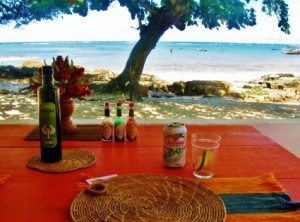
Photo © Michael Sommers.
My sister and I love to eat well, and – viewed our career choices, if possible – cheaply. Whenever we stumble upon a restaurant that combines these two attributes, we pretty much tumble into ecstasy.
We were fortunate to have honed our palates in cities where culinary expectations and offerings run pretty high: Paris (where I lived for 5 years) and New York (where my sister has lived for 15). As a result, like most people who have done time – and been spoiled by the gastronomic wealth – in such cities, we tend to be a little demanding in terms of what’s set down in front of us.
Apart from the food, the kindness of our hosts and the idyll of the setting contributed enormously to our desire to make this lunch experience last as long as possible.During our recent trip through southern Bahia, my sister and I ate some passable food, some good food, and, on occasion, some very memorable food. There were some unexpected surprises (the astonishingly fresh sushi and sashimi served in a hole-in-the-wall, Japanese bar/convenience store in Porto Seguro); some disappointments (the rubbery grilled octopus served at highly acclaimed luxury hotel in Itacaré), and some lifesavers (the per-kilo buffet in Trancoso where dozens of hot dishes, bubbling away on a wood-burning stove, provided sustenance and comfort while torrential rains fell outside). But at the end of the trip, when we pooled our experiences, there was one singular meal that, hands-down, blew all the rest out of the water:
It was our second day on the wonderfully secluded island of Boipeba and, taking advantage of low tide, we had decided to embark upon a walk from the small fishing village of Velha Boipeba (pop. 1600) to the even smaller fishing village of Moreré (pop. 250). Our journey took us along deserted beaches and over trails that crossed a Coca-Cola colored river and cut through Atlantic rainforest and coconut plantations. The jaw-droppingly scenic trek took over 2 hours and by the time we got to Moreré, we were starving.
Although there were a few basic beach bars to choose from, we’d received an insider tip from Charles, the friendly American owner of our guesthouse, Pousada Santa Clara, to try a brand new restaurant opened by a couple of transplants from São Paulo.
Technically, Samburá – (the name refers to a type of woven basket used by local fishermen) – isn’t a restaurant, but a simple, yet charming bungalow on the beach. Since April, the address has been the home of Giuliano and Estela, a professional couple that fell so in love with Boipeba’s natural charms that they decided to drop out, pack up, and with their three beloved lhasa apsos in tow, drive all the way up to Bahia where they intend to spend a year or two (or more). Their choice of Moreré stemmed from the fact that two of its adjacent beaches – Cueira and Bainema – are on “the list” of the Top 10 Most Beautiful Beaches in Brazil. Although there’s a certain subjectivity to these constantly evolving lists, I can definitely confirm that both finalists are worthy inclusions.
An amateur cook who loves rustling up meals for friends, Giuliano is also an inveterate traveler. Whenever he had a chance to take a trip, he’d inevitably track down accomplished cooks – both at 3-star restaurants and humble homes – and after tasting their creations, ask if he could watch and/or assist in their preparation. These years of informal apprenticeship not only inspired the couple to transform the three tables on the front veranda of their Moreré beach house into a restaurant, but also go a long way in explaining the utter delectability of the dishes served at Samburá.
In theory, you have to call ahead to reserve your meal – especially since many specialties, such as the legendary seafood paella, shrimp cooked in pumpkin, and lobster stroganoff, involve considerable preparation. However, when my sister and I showed up on their doorstep at high noon, Estela and Giuliano happily stored our belongings and pointed us to some inviting turquoise-jade ocean pools, promising that, within the hour, our lunch would be ready. We thus had ample time to float like hippos, collect sand dollars, and shower off in the garden before taking our seats on the shady veranda, our chairs facing the reefs where fishermen were pulling up their nets full of lobsters and crabs (on some days, Giuliano is out there with them).
Accompanied by pureed banana da terra (plantain) and a ceramic pot full of fluffy rice, the robust slabs of grilled robalo that were set down in front of us were – and I hate to use this word, but in this case it’s apt – sublime. The fish was so delicious – firm, flavorful, fragrant, and fresh (caught only hours before) – that one was faced with either wolfing it down ravenously, gluttonously, rapturously (my sister’s approach), or drawing out the pleasure to last a small eternity (my strategy) by consuming the melt-in-your-mouth flesh flake by flake.
Apart from the food, the kindness of our hosts and the idyll of the setting contributed enormously to our desire to make this lunch experience last as long as possible. When we finally emerged from our blissful daze, gathered our belongings, and said our goodbyes, we did so with the implicit knowledge that any other meal that followed would be an immense let-down. As such, not only did we take vows to fast for the rest of the day, but we actually adhered to them.
Samburá is open daily for lunch and dinner (except some Mondays). Call in advance (75/3653-8912) to reserve the time and the dish(es) you want (Estela speaks English).